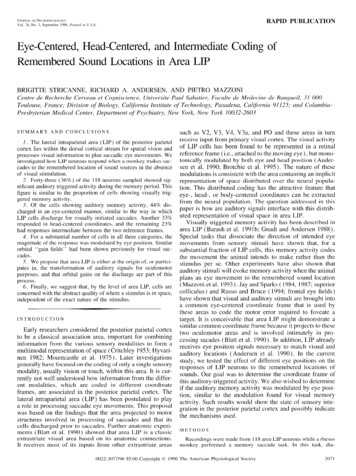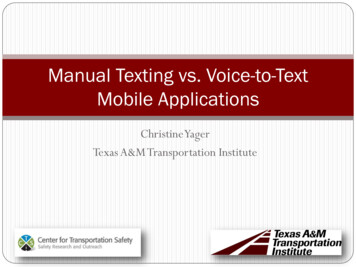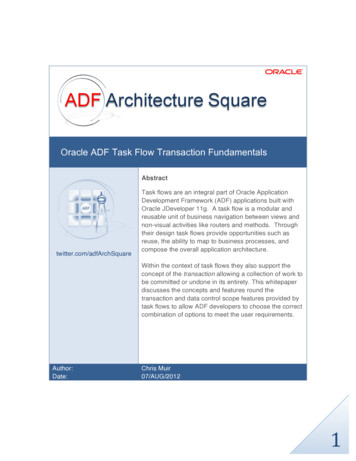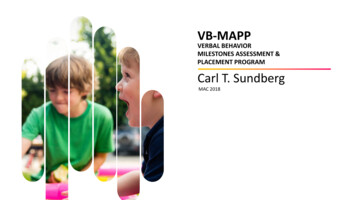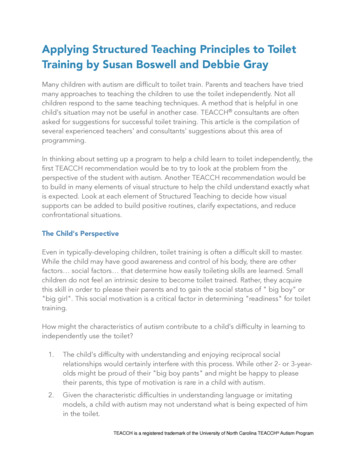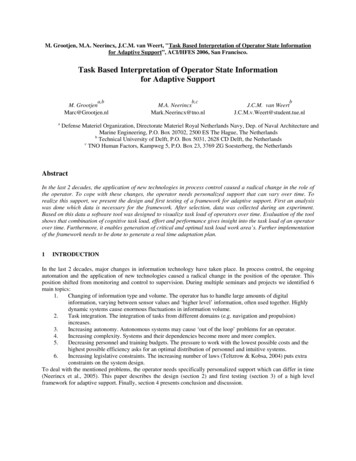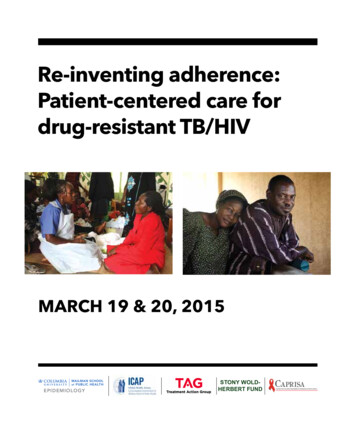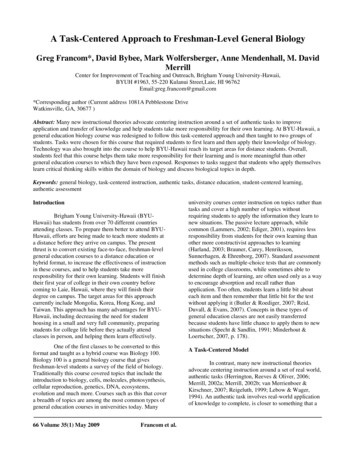
Transcription
A Task-Centered Approach to Freshman-Level General BiologyGreg Francom*, David Bybee, Mark Wolfersberger, Anne Mendenhall, M. DavidMerrillCenter for Improvement of Teaching and Outreach, Brigham Young University-Hawaii,BYUH #1963, 55-220 Kulanui Street,Laie, HI 96762Email:greg.francom@gmail.com*Corresponding author (Current address 1081A Pebblestone DriveWatkinsville, GA, 30677 )Abstract: Many new instructional theories advocate centering instruction around a set of authentic tasks to improveapplication and transfer of knowledge and help students take more responsibility for their own learning. At BYU-Hawaii, ageneral education biology course was redesigned to follow this task-centered approach and then taught to two groups ofstudents. Tasks were chosen for this course that required students to first learn and then apply their knowledge of biology.Technology was also brought into the course to help BYU-Hawaii reach its target areas for distance students. Overall,students feel that this course helps them take more responsibility for their learning and is more meaningful than othergeneral education courses to which they have been exposed. Responses to tasks suggest that students who apply themselveslearn critical thinking skills within the domain of biology and discuss biological topics in depth.Keywords: general biology, task-centered instruction, authentic tasks, distance education, student-centered learning,authentic assessmentIntroductionBrigham Young University-Hawaii (BYUHawaii) has students from over 70 different countriesattending classes. To prepare them better to attend BYUHawaii, efforts are being made to teach more students ata distance before they arrive on campus. The presentthrust is to convert existing face-to-face, freshman-levelgeneral education courses to a distance education orhybrid format, to increase the effectiveness of instructionin these courses, and to help students take moreresponsibility for their own learning. Students will finishtheir first year of college in their own country beforecoming to Laie, Hawaii, where they will finish theirdegree on campus. The target areas for this approachcurrently include Mongolia, Korea, Hong Kong, andTaiwan. This approach has many advantages for BYUHawaii, including decreasing the need for studenthousing in a small and very full community, preparingstudents for college life before they actually attendclasses in person, and helping them learn effectively.One of the first classes to be converted to thisformat and taught as a hybrid course was Biology 100.Biology 100 is a general biology course that givesfreshman-level students a survey of the field of biology.Traditionally this course covered topics that include theintroduction to biology, cells, molecules, photosynthesis,cellular reproduction, genetics, DNA, ecosystems,evolution and much more. Courses such as this that covera breadth of topics are among the most common types ofgeneral education courses in universities today. Many66 Volume 35(1) May 2009Francom et al.university courses center instruction on topics rather thantasks and cover a high number of topics withoutrequiring students to apply the information they learn tonew situations. The passive lecture approach, whilecommon (Lammers, 2002; Ediger, 2001), requires lessresponsibility from students for their own learning thanother more constructivist approaches to learning(Harland, 2003; Brauner, Carey, Henriksson,Sunnerhagen, & Ehrenborg, 2007). Standard assessmentmethods such as multiple-choice tests that are commonlyused in college classrooms, while sometimes able todetermine depth of learning, are often used only as a wayto encourage absorption and recall rather thanapplication. Too often, students learn a little bit abouteach item and then remember that little bit for the testwithout applying it (Butler & Roediger, 2007; Reid,Duvall, & Evans, 2007). Concepts in these types ofgeneral education classes are not easily transferredbecause students have little chance to apply them to newsituations (Specht & Sandlin, 1991; Minderhout &Loertscher, 2007, p. 178).A Task-Centered ModelIn contrast, many new instructional theoriesadvocate centering instruction around a set of real world,authentic tasks (Herrington, Reeves & Oliver, 2006;Merrill, 2002a; Merrill, 2002b; van Merrienboer &Kirschner, 2007; Reigeluth, 1999; Lebow & Wager,1994). An authentic task involves real-world applicationof knowledge to complete, is closer to something that a
professional in the field would do, and appliesmental models; holistic representations of parts,knowledge from more than one subject area. Reigeluthrelationships, conditions, actions and consequences of aexplains that the first task should be the simplest form ofcomplete task (Merrill & Gilbert, 2008, p. 4; Merrill,a task that a professional would actually do, and2007, 2002, p. 5). Centering instruction on tasks requiressubsequent tasks should increase in complexity (1999, p.students to apply the information they learn in class to442). Examples of such learning tasks in the domain ofnew situations. In First Principles of Instruction, Merrillbiology include requiring students to find out if a certainprescribes that tasks used in instruction should beobserved trait is heritable, or having students determine ifdemonstrated to the students, and that students should bea certain chemical found in nature is actually man-made.required to complete multiple whole tasks which applyThese tasks, while complex, can be simplified and donesome of the same information so these tasks can beby students if they are given the necessary support.compared to each other (2002a, p. 46).Merrill hypothesizes that centering instructionaround a set of authentic tasks allows students to formFigure. 1. A graphical representation of a task-centered instructional strategy.Instructional tasks should be designed to make studentsapply information they have learned to the task so thatthe experience of working through the task is added intoa student's mental model along with the information(Merrill, 2002b). Instructional strategies that follow atask-centered approach should not present anyinformation to students that is not applied to a task.examined his existing course and decided on topics thatcould be taken out of the course and those that wereessential for students to form a foundation in biology. Hechose to incorporate tasks into the course that fit withinthese different areas; the process of science, essentialchemistry, cells, genetics, evolution, and ecology.The Task-Centered DesignThe existing BYU-Hawaii Biology 100 coursewas converted to follow this task-centered approach. Oneof the major trade-offs in this process was sacrificingbroad information coverage for a deeper coverage ofeach topic. It takes more time to learn and apply aconcept to a unique task than it does to just ―skim‖ theconcept. Dr. David Bybee, the Biology 100 instructor,A Task-Centered ApproachBioscene 67
Figure. 2. The Biology 100 course online.Tasks within these areas allowed students toapply their knowledge of biology to a new situation. Forinstance, in the process of science section, studentslearned information about the process of science and thencompleted three tasks that required application of theirknowledge of the process of science. Students werescaffolded (Wood, Bruner, & Ross, 1976) to help themproperly apply the information they learned to the tasksthrough in-class presentations that presented onlyinformation that was pertinent to the current task andhow the information could be applied to tasks.Scaffolding in this class involved explicitly showingstudents how to complete the first task in a subject areausing information about the process of science, thendiminishing the level of support given to students foreach subsequent task that students complete in thesubject area. Information in the course was applied soonafter it was presented. At the beginning of class Dr.Bybee explained to students some of the key differencesbetween this class and a traditional general educationclass at BYU-Hawaii to help them understand what theirexperience would be like.Basic information presentation, includingtextbook reading and lecture information has been movedfrom playing a central to a supportive role. Most of thetasks that Dr. Bybee chose for students to completerequired students to understand certain concepts anddefinitions before being able to complete the task. Thisinformation was provided to the students in a variety offormats, including their textbook, classroompresentations and carefully prepared online tutorials.Traditionally this Biology 100 class required reading theentire textbook. In the redesign, students were asked toread only the pages in the textbook that apply to the taskat hand. Since the tasks are not bound to a specificsubject area, students had to gain background knowledgeof additional concepts and definitions. They viewedonline tutorials and listened to in-class presentations togive them this knowledge.Figure. 4. An online tutorial that tells about Plankton.Figure. 3. A chart that was presented to students on thefirst day of class to help them understand what theirexperience would be like.Student Activities – Before ClassStudents were involved in a minimum of threetasks from each topic area. Before each class, studentswere first presented with a task before learning about thesubject area or knowing how to complete the task.Students accessed this task online in a course68 Volume 35(1) May 2009Francom et al.
management system. Students then read their shortenedtextbook reading and other information that was relevantto the task. Because students had already read the task,the textbook reading was designed to help them gatherinformation to help them complete the task.For example, in the Ecology section of the class,students were required to read a real-world case studyinvolving a description of trophic interactions in anisolated environment. Then questions were posed tostudents in this case study about these interactions. Thecase study and questions made up the first task thatstudents should complete. Students who did not yet haveknowledge of ecology would likely not be able to answerthe questions when reading the case study for the firsttime, but they were encouraged to think about how thematerial presented in the task related to ecology. Studentsnext read about 22 pages of their textbook that wereselected because of their relevance to the case study. Asstudents read in the textbook, they were encouraged tolook for clues that helped them to complete the task byanswering the questions in the case study. In this processof reading and thinking about the task, students began tounderstand ecology and the task before coming to thefirst ecology class session.Student Activities – In ClassIn each class, the instructor showed studentshow the information that they read could be applied tothe task. Then the instructor presented a second task butdiminished support for the task by demonstrating only apartial solution to the task. The instructor explained howinformation read in the textbook and elsewhere could beapplied to complete the second task. Students broke intogroups and solved the rest of this second task with eachother. This peer interaction gave students the opportunityto discuss their knowledge of the topic area and task andthe relationship between them. They defended their ownresponses to the task when disagreements arose.Figure. 5. The weekly student process of before class, inclass and after class activities.Several classroom observations revealed thatstudents participated well in demonstrations and enjoyedthe instructor's presentations. Observers also noticed thatgroup discussion time was quite animated. In one classsession, students in groups debated and discussed the roleof mitosis and meiosis in the redistribution ofchromosomes and explained other pertinent geneticsconcepts to each other.The task in which students were engaged duringone observation was a genetics problem called Desiree'sBaby (Schnieder, 2003). Desiree's Baby is a tragic storyabout a woman in the 1800's who has a baby that beginsto show signs of mixed race in skin color. Her racisthusband requires her to leave. Heartbroken, Desiree takesher own life and her baby's. Later the husband discoversthat he is actually the person whose family line containsmixed race genes. The task required students to applygenetics to this story by discussing their knowledge ofinheritance patterns and draw conclusions based on thisknowledge. This story was not sanitized of other topicssuch as racism and 1800s culture, which was one reasonthat it was interesting to students. Almost all studentswere taking very active roles either explaining a conceptor listening to one another. Many students also referredto their textbook and websites via laptop for moreinformation on genetics.Student Activities – After ClassAfter each class, students worked on a thirdtask. In the genetics section, students worked on a casestudy about the occurrence of people with bluepigmentation in their skin (Leander & Husky, 2008).Their homework was to determine possible causes of thisskin pigmentation, how to test for these causes, andwhether this blueness in the skin is a heritable trait basedon family trees. Students posted individual answers tothese problems in an online course management systemand then compared their answers to those in their groupA Task-Centered ApproachBioscene 69
of up to 4 people. Then, as a group they negotiated afinal response to submit to their instructor. Because thetask was complex, there were a variety of answers givenby individual students and groups. Most studentshypothesized that perhaps the level of oxygen in the redblood cells was low for varying reasons, mainly genetics.Other responses speculated about the introduction offoreign drugs into the body, or environmental andlifestyle circumstances. Students also indicated ways thatthey could test these hypotheses, including studying thefamily tree of the people involved or studying theenvironment in which they live. Here is a quote from oneof the group responses:The first [.] hypothesis that we considered wasthat this skin formation was [due to a lack] of acertain enzyme called diaphorase, as a result,blood levels of those who suffer from met-HB(methemoglobin) have a shortage of oxygencarrying competence, also because this triggersmethemoglobin levels [to] soar. Therefore, it isrepresented in the human being by the bluishtinge found on their bodies.To test this particular idea, we would compareblood samples of those who suffer from met-Hband those who do not, and devise a way tomeasure the oxygen levels [in] the bloodstreams.There was always someone within the pedigreechart who was a carrier of the recessivemethemoglobinemia (met-H) gene, whichlimited and/or stopped the body's production ofthe enzyme diaphorase (which breaks downmethemologbin into hemoglobin in red bloodcells). The absence of this enzyme produced adisproportionate amount of methemoglobin inthe blood, tinting it blue [.] People aflicted[sic] with this genetic disorder have skin whichis literally purple-blue in color and dark purplelips. The hemoglobin in their blood has areduced ability to carry oxygen which producesthe blue color of their skin. The dominant,normal allele is responsible for the production ofan enzyme (protein), called diaphorase thatreduces the hemoglobin so it can be reused andpick up more oxygen.All student group solutions included a familytree that represented the family in question and listedtheir traits in a genetic chart. Other unit tasks weresimilar to this one. Students were required to post theirindividual response to the task and then discuss eachother's responses online in groups and decide on a finalgroup response. Dr. Bybee observed that, relative to histraditional general biology class, students who investedtheir time in these online discussions were involved in adeeper level of discussion, and had an increased feelingof the importance of biology as a field of study.Another response to the same problem given bya different group of students includes the followingobservation;Figure. 6. A group solution to an ecology problem in the Biology 100 online discussion board.70 Volume 35(1) May 2009Francom et al.
AssessmentIn contrast to the traditional method of generaleducation biology teaching at BYU-Hawaii, whichoften uses multiple choice tests to assess students‘understanding of biology, a student's grade in thisBiology 100 course is based mostly on authenticmethods of assessment that determine how well theycan apply information to a unique task. Assessment inthe Biology 100 course is based on three maincomponents. First and most importantly, a student'sindividual posts and group responses are graded basedon how well they apply their knowledge of the topicarea to the task, how thoroughly they outline the topicarea, how well the evidence from the task is used tocomplete it, how well items read in the textbook andexperiences in the class are applied, and grammaticalcorrectness. These elements were part of a gradingrubric used by the biology instructor to assess theability of students to apply the knowledge they learned.Next, students report on how well they prepared foreach class by choosing from options in a specificrubric. Finally, students rank each other on how wellthey contributed in the group work during each task.Authentic assessment, including gradingstudents ability to apply information to a task, focuseson deep understanding and application of knowledge(Gulikers, Bastiaens, & Kirschner, 2004; MacAndrew& K. Edwards, 2002; Oh, Kim, Garcia, & Krilowicz,2005). Authentic assessment measures given by theinstructor when measuring the application ofknowledge have been found to be reliable and validwith high inter-rater reliability between internal andexternal experts in both written responses and oralpresentations (MacAndrew & Edwards, 2002; Oh etal., 2005). Authentic assessment methods have alsobeen found to measure application of learning ratherthan just ―surface‖ learning (Reid et al., 2007;Gulikers, Kester, Kirschner, & Bastiaens, 2008). Selfgrading increases student responsibility for learningand has been found to be a valid method of assessmentwhen students follow a specific rubric (Edwards, 2007;Sadler & Good, 2006; Strong, Davis, & Hawks, 2004).Cheating and grade inflation are possible risks in selfgrading, but studies have shown that the benefits ofself-grading, including increased motivation andlearning opportunities often outweigh the risks (N. M.Edwards, 2007; Strong et al., 2004). Peer-ranking as anassessment technique has been used in a variety ofsituations with high reliability and validity (Cho,Schunn, & Wilson, 2006; Magin, 2001; Wen & Tsai,2006) especially when used with forced distribution(ranking) (Ryan, Marshall, Porter, & Jia, 2007).EvaluationBiology 100 has gone through one iteration offormative evaluation. This formative evaluation wasconducted at BYU-Hawaii as a hybrid course with 89students in 2 classes. Student perception results fromthis pilot test will be used to help BYU-Hawaii bringgeneral biology to its target areas. The instruments ofthe evaluation included classroom observation,instructor observations, a class survey, and onlinediscussion observations.Students took a little while to get used to theformat of this course which is radically different fromother courses that they have taken at BYU-Hawaii. Atthe beginning of the course students had to learn to usean online learning management system, negotiate anunfamiliar grading scale, and learn to increaseresponsibility for their own learning. The perceivedfrustration level among students in the classesdecreased from high at the beginning of the semester tolow as students got used to the course format. Almostall other courses at BYU-Hawaii require attendance, sowhen this course did not require it, some students tookthe liberty of not coming. Despite all of the warningsgiven to students about how this course would bedifferent than what they are used to, some students stilltreated this course as a traditional higher educationcourse. As time goes on and more courses give moreresponsibility for learning to the students, they willlikely begin to understand how to take thatresponsibility seriously.Several classroom observations showed thatoverall, students actively participated in classdiscussions. However some students decided not totake responsibility for their own learning and avoidedgroup discussion. Discussion groups were usuallyformed by culture and friendships since students wereallowed to form their own groups. Plans are beingmade to conduct an instructor training that will helpaddress some of these concerns. Group formation willbe changed to make sure that small and cross-culturalgroups will be formed and to require more effectiveparticipation.Throughout the course, students' tasksolutions showed that they gained a deep understandingof biological topics. Dr. Bybee observed that some ofhis freshman students in this Biology 100 course wereable to complete problems and tasks that he had usedwith his senior level students. This observationsuggests that this course helps students learn criticalthinking skills within the domain of biology and makeconclusions that are similar to ones made by moreexperienced biology students.88 students responded to an online surveyabout the Biology 100 class. Ninety-two percent agreedthat this class gave them the opportunity to applyknowledge in meaningful ways. Over 81% felt thattheir interest in Biology increased as a result of thisA Task-Centered ApproachBioscene 71
class. Over 76% liked this class better than othergeneral education classes they had taken. At least 92%of students felt Biology 100 helped them improve theircritical thinking skills and 76% felt that it helped themimprove their reading and writing skills.Of course, not all survey responses werefavorable. Almost 60% of students felt that onlinediscussions were the least helpful activity to theirlearning. Observations on these discussions indicatethat some students did not take these activitiesseriously, and some of the online discussion tasks werenot complex enough to allow for differing solutions.Many (68%) students felt that the required readings(tasks, and textbook reading about the tasks) were themost helpful activities for their learning.When responding to, ―I would suggest thefollowing items to improve the Biology 100 class forfuture students,‖ Student responses generally fell intofour areas: improve grading and feedback to make itmore prompt, improve the organization in the course sothat students understand their expectations, remove thepeer-ranking elements of the course, and mandate inclass attendance. Other responses not in thesecategories include the following: ―Please give us classmore than once a week. Please destroy the gradingsystem and rework it entirely. Please don't turn ateacher into an online supervisor for an internetcourse.‖ Another student showed his/her desire toreturn to a traditional course format with the followingcomment, ―Stop using blackboard and stick to thesystem that works- tests and quizzes.‖Students also responded to the statement, ―Iespecially liked the following aspects of the Biology100 course,‖ and responses to this statement also fellinto four main categories: problems that allow learnersto apply information to a unique situation, the lack ofexams, the instructor's presentations, and in-class andonline group work. One sample response to thisstatement illustrated a common feeling of satisfactionin being able to apply information to tasks: ―Theproblems, how applicable everything was to real eventsand life [.] It was so awesome, and so helpful forapplying book-knowledge to real life. LOVE it!‖Another comment highlighted student responsibility forlearning in the class:What I did like is the idea behind the class. Its[sic] much more geared towards effectivelearning because its more about the educationrather than memorizing for the test. I think thephilosophy of the class is unique because itallows kids to really learn if they take the timeto apply themselves. its [sic] a bit more selfguided than other classes so the students needto be serious about learning.72 Volume 35(1) May 2009Another student responded with enthusiasm for thelack of tests in the class, ―No tests! i [sic] liked thelearning method of learning through our own analysisand discussions with others, it was new andinteresting.‖One student's response summed up the mainpurposes of this course redesign:The readings helped me understand the basisfor what we were discussing, and in-classdiscussions and instructor presentationshelped me to focus that knowledge and comeup with possible solutions to real problems.On line discussions helped me to develop mycritical thinking skills more on my ownbecause I was forced to come up with my ownhypothesis, and argue either for or againstothers. This helped to hone my ability to thinkin a way that applied both what I learned frombeing in class, from the readings, and fromoutside information and logic. I LOVED thisclass!DiscussionThe observations and survey findings indicatethat overall, students were excited and motivated inBiology 100. They especially enjoyed being able toapply information to complete relevant tasks and takemore responsibility for their own learning. Moststudents preferred this method of teaching to othergeneral education teaching methods to which they hadbeen exposed. One limitation to the findings is thatthere was no systematic comparison of the performanceof this class to another similar general biology classtaught in the original way using lectures and tests.Using both authentic and traditional assessment in eachclass would help determine what types of knowledgestudents are learning and allow a comparison betweenthe different classes. Another limitation is that theoriginal Biology 100 final was not administered tostudents in this Biology 100 course. Results from theoriginal final would indicate if students actually didgain a general knowledge of biology concepts inaddition to the applied knowledge already measured bythe instructor in students‘ task solutions. The focus ofthis course was application of concepts rather thanmemorization of biology concepts, but results from theoriginal final would indicate if students actually didremember concepts through their application. A thirdlimitation is that individuals who had a stake in theoutcomes of classroom observations did theseobservations. So confirmation bias could have played apart in the report of classroom observations despite theobservers‘ efforts to be objective.Francom et al.
RevisionsBased on the survey results, feedback will beimproved to give grades promptly for studentperformance. Problems will be examined forcomplexity and some will be switched out for moreapplicable problems that will help improve groupdiscussion. Future revisions to the course includeconducting a traditional final test for all students andpeer grading of group solutions to tasks is also plannedto allow students to review and learn from each other'sgroup solutions.Revisions are currently being made to theBiology 100 course to prepare it to go out to itsintended target areas. It is planned to be tested in Asiain January, 2009. Further evaluation data will begathered to investigate the effectiveness of thisapproach to teaching general biology to BYU-Hawaii'starget areas.ReferencesHERRINGTON, J., REEVES, T. C., AND R. OLIVER. 2006.Authentic Tasks Online: A Synergy among Learner,Task, and Technology. Distance Education, 27(2):233-47.LEANDER, C. AND J. HUSKY. 2008. Those OldKentucky Blues: An Interrupted Case Study. Accessedfrom,http://www.sciencecases.org/blue people/blue people.asp on 13 June, 2008.MERRIENBOER, J. J. V., AND P. A. KIRSCHNER. 2007.Ten Steps to Complex Learning: A SystematicApproach to Four-Component Instructional Design.Lawrence Erlbaum and Associates Publishers, London.306p.MERRILL, M. D. 2002a. First Principles of Instruction.Educational Technology Research and Development,50(3): 43-59MERRILL, M. D. 2002b. A pebble-in-thepond model for instructional design. PerformanceImprovement,41(7): 39-44REIGELUTH, C. M. 1999. The Elaboration Theory:Guidance for Scope and Sequencing Decisions.In C. M. Reigeluth (Ed.). Instructional-DesignTheories and Models: A New Paradigm ofInstructional Theory, Vol. 2. LawrenceErlbaum and Associates Publishers, London. 715p.SCHNIEDER, P. 2003. The Case of Desiree's Baby: TheGenetics and Evolution of Human SkinColor.Accessed fromhttp://www.sciencecases.org/skin color/skin color.aspon 15 June, 2008.A Task-Centered ApproachBioscene 73
students for college life before they actually attend classes in person, and helping them learn effectively. One of the first classes to be converted to this format and taught as a hybrid course was Biology 100. Biology 100 is a general biology course that gives freshman-level st
